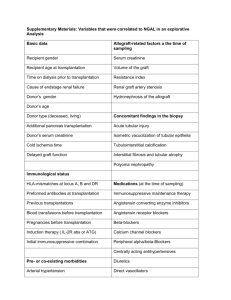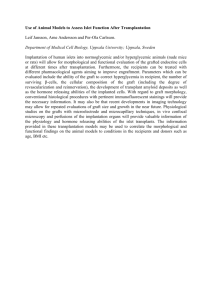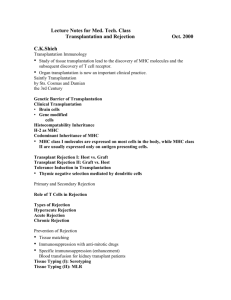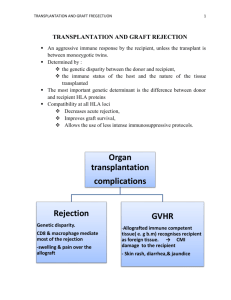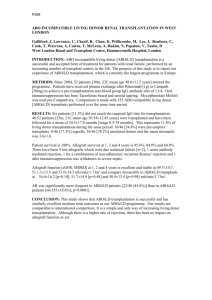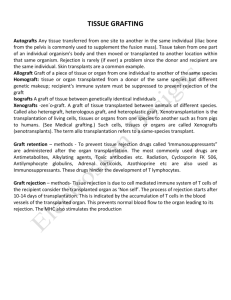Transplantation Immunology
advertisement
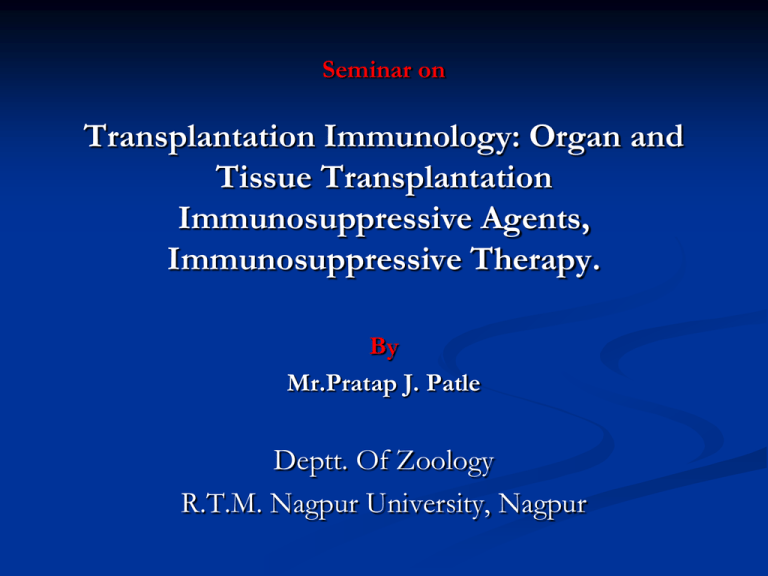
Seminar on Transplantation Immunology: Organ and Tissue Transplantation Immunosuppressive Agents, Immunosuppressive Therapy. By Mr.Pratap J. Patle Deptt. Of Zoology R.T.M. Nagpur University, Nagpur Contents Introduction Immunology of Transplant Rejection Tissue and Organ Transplantation Immunosuppressive Agents Immunosuppressive Therapy Conclusion References Introduction Transplantation immunology - sequence of events that occurs after an allograft or xenograft is removed from donor and then transplanted into a recipient. A major limitation to the success of transplantation is the immune response of the recipient to the donor tissue. Types of Transplant Autograft is self-tissue transferred from one body site to another in the same individual. Isograft is tissue transferred between genetically identical individuals. Allograft is tissue transferred between genetically different members of the same species. Xenograft is tissue transferred between different species Immunology of Transplant Rejection Components of the Immune system involved in graft Rejection : 1) Antigen presenting cells – Dendritic cells Macrophages Activated B Cells 2) B cells and antibodies – Preformed antibodies Natural antibodies Preformed antibodies from prior sensatization Induced antibodies 3) T cells 4) Other cells – Natural killer cells T cells that express NK cell – associated Markers Monocytes/Macrophages The Immunology of Allogeneic Transplantation Recognition of transplanted cells that are self or foreign is determined by polymorphic genes (MHC) that are inherited from both parents and are expressed co-dominantly. Alloantigens elicit both cell-mediated and humoral immune responses. Recognition of Alloantigens Direct Presentation Recognition of an intact MHC molecule displayed by donor APC in the graft Basically, self MHC molecule recognizes the structure of an intact allogeneic MHC molecule Involves both CD8+ and CD4+ T cells. Indirect Presentation Donor MHC is processed and presented by recipient APC Basically, donor MHC molecule is handled like any other foreign antigen Involve only CD4+ T cells. Antigen presentation by class II MHC molecules. Activation of Alloreactive T cells and Rejection of Allografts Donor APCs migrate to regional lymph nodes and are recognized by the recipient’s TH cells. Alloreactive TH cells in the recipient induce generation of TDTH cell and CTLs then migrate into the graft and cause graft rejection. Activation of Alloreactive T cells and Rejection of Allografts ( SENSATIZATION ) Passenger leukocyte Donar kidney Class II MHC . antigen TH TH TH TH IL 2 CTL CTL TDTH TDTH EFFECTOR LYMPH NODE Role of and + CD8 T Cells CD4+ differentiate into cytokine producing effector cells + CD4 Damage graft by reactions similar to DTH CD8+ cells activated by direct pathway kill nucleated cells in the graft CD8+ cells activated by the indirect pathway are self MHC-restricted Role of Cytokines in Graft Rejection IL – 2, IFN – , and TNF - are important mediators of graft rejection. IL – α promotes T-cell proliferation and generation of T – Lymphocytes. IFN - is central to the development of DTH response. TNF - has direct cytotoxic effect on the cells of graft. A number of cytokines promote graft rejection by inducing expression of class – I or class – II MHC molecule on graft cell. The interferon (α, and ), TNF – α and TNF - all increases class – I MHC expression, and IFN - increases class – II MHC expression as well. Effector Mechanisms of Allograft Rejection Hyperacute Rejection Acute Rejection Chronic Rejection Hyperacute Rejection Characterized by thrombotic occlusion of the graft Begins within minutes or hours after anastamosis Pre-existing antibodies in the host circulation bind to donor endothelial antigens Activates Complement Cascade Xenograft Response Hyperacute Rejection 1. Preformed Ab, 2. complement activation, 3. neutrophil margination, 4. inflammation, 5. Thrombosis formation Acute Rejection Vascular and parenchymal injury mediated by T cells and antibodies that usually begin after the first week of transplantation if there is no immunosuppressant therapy Incidence is high (30%) for the first 90 days Acute Rejection 1. T-cell, macrophage and Ab mediated, 2. myocyte and endothelial damage, 3. Inflammation Chronic Rejection Occurs in most solid organ transplants Heart Kidney Lung Liver Characterized by fibrosis and vascular abnormalities with loss of graft function over a prolonged period. Chronic Rejection 1. Macrophage – T cell mediated 2. Concentric medial hyperplasia 3. Chronic DTH reaction Tissue and Organ Transplantation Today it is possible to transplant many different organs and tissues including. Most common transplantation is blood transfusion. Bone Marrow transplantation Organs : Heart, kidneys, pancrease, lungs, liver and intestines. Tissues : include bones, corneas, skin, heart values, veins, cartilage and other connective tissues. Most Common Transplantation -Blood Transfusion- Transfuse Not transfused Bone Marrow Transplantation Used for Leukemia, Anemia and immunodeficiency, especially severe combined immunodeficiency (SCID). About 109 cells per kilogram of host body weight, is injected intravenously into the recipients. Recipient of a bone marrow transplant is immunologically suppressed before grafting. Eg. Leukemia patients are often treated with cyclo-phosphamide and total body irradiation to kill all cancerous cells. Because the donor bone marrow contains immunocompetent cells, the graft may reject the host, causing graft versus host disease (GVHD). Graft vs. Host Disease Caused by the reaction of grafted mature T-cells in the marrow inoculum with alloantigens of the host Acute GVHD Characterized by epithelial cell death in the skin, GI tract, and liver Chronic GVHD Characterized by atrophy and fibrosis of one or more of these same target organs as well as the lungs Heart Transplantation : First heart transplant in South Africa by Dr. Christian Barnard in 1964. One year survival rate is >80%. HLA matching is desirable but not often possible, because of the limited supply of heart and the urgency of the procedure. Lung Transplantation : First attempt in 1963 by Hardy and Co - workers. First successful transplantation by Toronto group in 1983. In conjunction with heart transplantation, to treat diseases such as cystic fibrosis and emphysema or acute damage to lungs. First year survival rate is about 60%. Kidney Transplantation : Diseases like diabetes and various type of nephritis can be elleviated by kidney transplantation. Survival rate after one year transplantation is >90%. 25,000 candidates are waiting for kidney transplantation. Liver transplantation : It treat congenital defects and damage from viral (hepatitis) or chemical agents. (Chronic alcoholism). Liver one year survival exceeds 75% and five year is 70%. Pancrease Transplantation : Offers a cure for diabetes mellitus. Graft survival is 72% at one year. Further improved if a kidney is transplanted simultaneously. Overall goal - to prevent the typical diabetic secondary complications. Skin grafting : It is used to treat burn victims. In severe burn, grafts of foreign skin may be used and rejection must be prevented by the use of immunosuppressive therapy. Xenogeneic Transplantation A major barrier to xenogeneic transplantation is the presence of natural antibodies that cause hyperacute rejection. Immunosuppressive Agents Immunosuppression can be brought about by 3 different ways : Surgical ablation Total Lymphoid Irradiation Immunosuppressive drugs Immunosuppressive Drugs Three main immunosuppressant drugs Cyclosporins act by inhibiting T-cell activation, thus preventing T-cells from attacking the transplanted organ. Azathioprines disrupt the synthesis of DNA and RNA and cell division. Corticosteroids such as prednisolone suppress the inflammation associated with transplant rejection. Immunosuppressants can also be classified depending on the specific transplant: Basiliximab in combination with cyclosporin and corticosteroids, in kidney transplants. Daclizumab in combination with cyclosporin and corticosteroids, in kidney transplants. muromonab CD3 (Orthoclone OKT3) along with cyclosporin, in kidney, liver and heart transplants. Tacrolimus is used in liver transplants and is under study for kidney, bone marrow, heart, pancreas, pancreatic island cell, and small bowel transplantation. Some immunosuppressants are also used to treat a variety of autoimmune diseases: Azathioprine in treatment of rheumatoid arthritis , chronic ulcerative colitis but limited value. Cyclosporin is used in heart, liver, kidney, pancreas, bone marrow and heart/lung transplantation. Also used to treat psoriasis and rheumatoid arthritis, multiple sclerosis, diabetes and myesthenia gravis. Glatiramer acetate is used in treatment of relapsing-remitting multiple sclerosis. Mycophenolate is used along with cyclosporin in kidney, liver and heart transplants. Also used to prevent the kidney problems associated with lupus erythematosus. Sirolimus in combination with cyclosporin and corticosteroids, in kidney transplants. The drug is also used for the treatment of psoriasis. Immunosuppressive Therapy Monoclonal antibodies To suppress the activity of subpopulation of T-cells. To block co-stimulatory signals. Ab to the CD3 molecule of TCR (T cell receptor) complex results in a rapid depletion of mature T-cells from the circulation. Ab specific for the high-affinity IL-2 receptor is expressed only on activated T-cell, blocks proliferation of T-cells activated in response to the alloantigens of the graft. To treat donor’s bone marrow before it is transplanted. Molecules present on particular T-cells subpopulation may also be targeted for immunosuppressive therapy. Antibody to CD4 shown to prolong graft survival. Ab specific for implicated cytokine can prolong the survival of graft. Conclusion More than 50,000 people, waiting for compatible donor. For ethical an practical reasons, species closely related to human such as Chimpanzee have not been widely used. Xenogeneic transplantation may be major issue of research xenograft technology including genetically modified animal may become a new source of organ supply. Side effects of immunosuppressive agent use for graft need a change of specificity in action and avoiding general immune suppression. Techniques such as transgenic animal production and wide range of research in this field hope to result in opening a new window for the process of transplantation immunology. References •Immunology by – Janis Kuby •Immunology by – Abdul Abbas •Immunology by – Roitt •Fundamental Immunology by – William E. Paul Information from – •www.organtransplants.org •www.transweb.org •www.organdonor.web Thank you ! This powerpoint was kindly donated to www.worldofteaching.com http://www.worldofteaching.com Is home to well over a thousand powerpoints submitted by teachers. This a free site. Please visit and I hope it will help in your teaching
